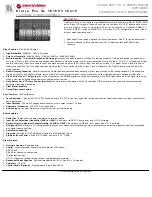
27-2
Data of an upper layer application module is sent to the IPC module through a channel, and the IPC
module sends the data to a peer node through the link. The relationship between a node, link and
channel is as shown in
Figure 27-1
.
Figure 27-1
Relationship between a node, link and channel
Node 1
IPC
Application 2
Application 3
Application 1
Node 2
IPC
Application 2
Application 3
Application 1
Cha
nne
l 1
Ch
an
ne
l 2
Packet sending modes
IPC supports three packet sending modes: unicast, multicast (broadcast is considered as a special
multicast), and mixcast, each having a corresponding queue. The upper layer application modules can
select one as needed.
z
Unicast: packet sending between two single nodes.
z
Multicast: packet sending between a single node and multiple nodes. To use the multicast mode,
a multicast group needs to be created first. Multicasts will be sent to all the nodes in the multicast
group. An application can create multiple multicast groups. The creation and deletion of a
multicast group and multicast group members depend on the application module.
z
Mixcast, namely, both unicast and multicast are supported.
Enabling IPC Performance Statistics
When IPC performance statistics is enabled, the system collects statistics for packet sending and
receiving of a node in a specified time range (for example, in the past 10 seconds, or in the past 1
minute). When IPC performance statistics is disabled, statistics collection is stopped. At this time, if
you execute the
display
command, the system displays the statistics information at the time when IPC
performance statistics was disabled.
Follow these steps to enable IPC performance statistics:
To do…
Use the command…
Remarks
Enable IPC performance
statistics
ipc performance enable
{
node node-id
|
self-node
}
[
channel channel-id
]
Required
Disabled by default
Available in user view









































